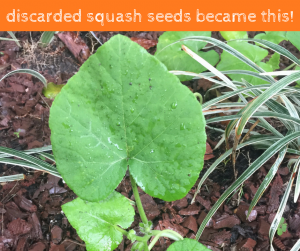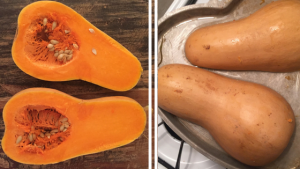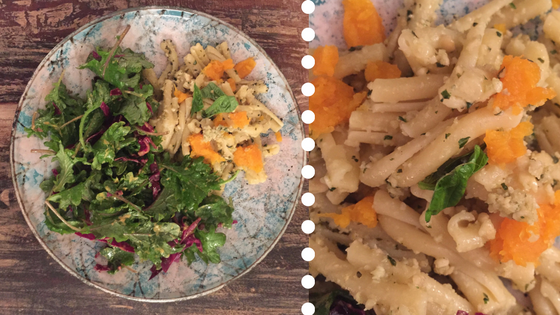Get Dirty + Butternut Pesto Pasta

My mom used to have a small garden in the backyard at our house in Massachusetts. There was nothing like our summer salads of tomatoes and cucumbers fresh from the garden. Heavy salad dressings would have masked the flavor. A pinch of salt was all that was needed. Pure nature. Pure goodness.
I have tried to grow herbs and various veggies on my own several times. I even started a ‘Gardening Girls’ club with two dear friends and we all took a half day gardening class last year. I pictured myself living off the grid and sharing my bounty with those less fortunate. However, my repeated attempts at gardening failed. I know now that I was trying too hard.
GARDENING IS EASY. THE POSITIVE ATTITUDE OF THE GARDENER IS AS IMPORTANT AS SUN, WATER AND SOIL.
I recently moved to a cottage on my friend Tim’s property. Although my cottage is small (and absolutely adorable), the land around it is plentiful and filled with life. We are blessed to have avocado, papaya and coco palm trees showering us with their fruits.
Safely ensconced in my new abode, I decided it was time to give gardening another try and enjoy homegrown cucumber and tomato salads again. Besides, the deadline to sign up for my local CSA had just passed – yet another sign. Thankfully, Tim was all for a garden and he is a ‘doer.’ In less than a week, he tilled the soil and planted young adult plants (pictured above top right). Voilá!, we now have lettuce and herbs ripe for the picking. The tomatoes, squash and cauliflower will take some more time to show fruit but they are well on their way. The basil from today’s pesto recipe is from our garden. How cool is that?
The easiest and fastest way to have a garden (provided you have healthy, nutrient-rich soil, which we do) is to plant young adult plants. However, if you want to take it to the next level, you can start with seeds. I purchased organic seeds, organic seed starter soil and biodegradable seed starter pots from Amazon Prime and in two days I was getting my own hands dirty. In less than a week, the seeds have grown into seedlings (pictured above top left and bottom right). I will transfer them into the ground in a couple of days. I will keep you posted but I have a very good feeling about this – and a positive attitude this time.
 Still not convinced gardening is easy? I had been throwing my vegetables scraps (orange rinds, onion clippings, squash seeds, etc.) into the front yard (aiming for the wooded area – and missing) for the first two months of cottage living. We noticed some mysterious leaves growing in the front yard. A quick Google search determined those leaves are the beginning signs of squash. OMG.
Still not convinced gardening is easy? I had been throwing my vegetables scraps (orange rinds, onion clippings, squash seeds, etc.) into the front yard (aiming for the wooded area – and missing) for the first two months of cottage living. We noticed some mysterious leaves growing in the front yard. A quick Google search determined those leaves are the beginning signs of squash. OMG.
Need yet another reason to start growing your own food? Gardening and getting your hands in the dirt, literally, has many health benefits like reducing stress and improving your mood. Connecting with nature is especially important for those of us with an office job and an important component of our overall self care. Click here for a CNN article, ‘Why Gardening Is Good For Your Health.’ The best part about gardening is eating what you grow, which brings me to my Butternut Pesto Pasta recipe.
Ingredients
- 4 garlic gloves peeled
- 1/4 cup walnuts (or cashews if you want a sweeter flavor)
- large handful of fresh basil, chopped
- 1/4 cup cold-pressed olive oil
- salt and pepper to taste
- red pepper flakes (optional)
- 1/4 - 1/2 cup cooked, chopped butternut squash (see bottom of post for instructions on cooking squash)
- 1/2 pound fusilli or other pasta
Instructions
- In a food processor, pulse garlic and walnuts until coarsely chopped
- Add chopped basil, pulse until mixed
- Add olive oil a little at a time until you have the desired consistency. I like a lot of olive oil but it's up to you
- Add salt and pepper to taste
- Add red pepper flakes to taste if you like pesto with a 'kick'
- Mix with pasta cooked al dente and chopped butternut squash
- Serve with a hearty salad for a complete, healthy meal
- Serves 4 hungry people
 A note on cooking squash:
A note on cooking squash:
I find the easiest way to cook butternut or acorn squash is to split it down the middle, scoop out the seeds and pulp, and cook it (skin on) upside down in a cookie sheet or shallow pan in 1/2 inch of water at 400 degrees for about an hour. I know it’s done when a knife cuts through it easily and the skin is slightly browned at the top. Just scoop out the squash to use in a recipe or slice it up with the skin on to include as a side dish.
Don’t forget to plant the seeds if you have some fertile soil and want to try your hand at gardening. Otherwise, you can roast and eat squash seeds. Seeds contain protein and are a good source of vitamins and minerals. Here’s a nice post from Mother Nature Network, ‘7 reasons to roast your squash seeds,’ which further explains the benefits of eating squash seeds. I love that we can benefit from the entire fruit. Yes, squash is a fruit!
CLICK HERE TO RECEIVE BELAVIE WEEKLY POSTS DIRECT TO YOUR INBOX PLUS A FREE GIFT.
READY TO TAKE YOUR HEALTH AND WELLNESS TO ANOTHER LEVEL THROUGH STRUCTURED HEALTH COACHING? CLICK HERE FOR A FREE 30-MINUTE CONSULTATION AND REVIEW OF YOUR HEALTH HISTORY.
CLICK HERE TO PURCHASE BEAUTY ITEMS ON MY SHOP PAGE.
CLICK THE BELOW BUTTONS TO SHARE THIS POST ON YOUR SOCIAL MEDIA OR EMAIL TO A FRIEND.




Looks delish!!!
I loved your post today. Beautiful descriptions and recipe and great photos. Keep us interested!
Thanks JC!
Cutting any winter squash requires a lot of pressure on the knife making the procedure quite hazardous.
Reduce risk and cook first.
I bake my squash whole at 400F in a shallow casserole dish until tender. Then, remove from oven, cut in half, scoop and discard seeds, and scoop out the flesh.
GREAT tip Tammy! Thanks.